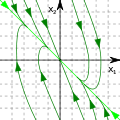
Proto-Cubism
Proto-Cubism (also referred to as Protocubism, Early Cubism, and Pre-Cubism or Précubisme) is an intermediary transition phase in the history of art chronologically extending from 1906 to 1910. Evidence suggests that the production of proto-Cubist paintings resulted from a wide-ranging series of experiments, circumstances, influences and conditions, rather than from one isolated static event, trajectory, artist or discourse. With its roots stemming from at least the late 19th century, this period is characterized by a move towards the radical geometrization of form and a reduction or limitation of the color palette (in comparison with Fauvism). It is essentially the first experimental and exploratory phase of an art movement that would become altogether more extreme, known from the spring of 1911 as Cubism.
Proto-Cubist artworks typically depict objects in geometric schemas of cubic or conic shapes. The illusion of classical perspective is progressively stripped away from objective representation to reveal the constructive essence of the physical world (not just as seen). The term is applied not only to works of this period by Georges Braque and Pablo Picasso, but to a range of art produced in France during the early 1900s, by such artists as Juan Gris, Jean Metzinger, Albert Gleizes, Henri Le Fauconnier, Robert Delaunay, Fernand Léger, and to variants developed elsewhere in Europe. Proto-Cubist works embrace many disparate styles, and would affect diverse individuals, groups and movements, ultimately forming a fundamental stage in the history of modern art of the 20th-century.[1]



